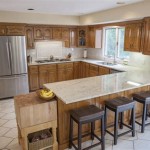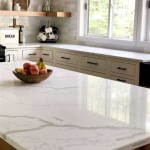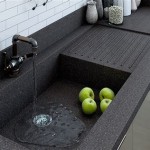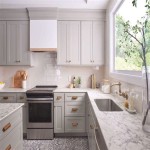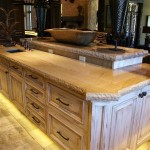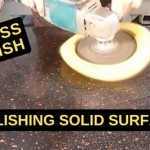Metal Supports for Granite Countertops: Ensuring Stability and Longevity
Granite countertops have long been favored for their aesthetic appeal, durability, and natural resistance to heat and scratches. Their inherent strength makes them a popular choice for both residential and commercial spaces. However, despite their robust nature, granite countertops often require additional support, particularly when spanning longer distances or featuring cutouts for sinks and appliances. Metal supports play a crucial role in maintaining the integrity and preventing potential damage to these valuable surfaces.
The need for support stems from the inherent weight of granite. A typical granite slab weighs approximately 13 pounds per square foot, at a thickness of 1 inch. This weight concentrates stress on any unsupported areas, leading to potential cracking or breakage over time. Metal supports, typically constructed from steel or aluminum, provide the necessary reinforcement to distribute this weight evenly and prevent these structural failures.
The installation of metal supports is not merely an optional measure but a critical component of ensuring the long-term stability and lifespan of a granite countertop. Ignoring or inadequately addressing the support requirements can result in costly repairs or even the complete replacement of the countertop. Proper support not only enhances the countertop's structural integrity but also contributes to the overall safety and functionality of the kitchen or bathroom environment.
Understanding the Factors Influencing the Need for Metal Supports
Several factors determine the necessity and type of metal supports required for a granite countertop. These factors include the countertop's dimensions, thickness, overhang, the presence of cutouts, and the underlying cabinet structure.
Countertop Dimensions: The length and width of the countertop significantly impact the need for support. Longer spans, especially those exceeding 36 inches without support, are particularly susceptible to cracking under their own weight. Similarly, wider countertops with significant overhangs require robust support to prevent tipping or breakage.
Countertop Thickness: While thicker granite slabs offer greater inherent strength, they are also heavier. A 3-centimeter (1.2-inch) thick slab will require less frequent support than a 2-centimeter (0.8-inch) slab over the same span. However, even thicker slabs benefit from strategic reinforcement, especially in areas prone to stress concentration.
Countertop Overhang: Overhang refers to the portion of the countertop that extends beyond the supporting cabinets or walls. Overhangs are desirable for creating breakfast bars or providing knee space at islands. However, unsupported overhangs are particularly vulnerable to breakage. Industry standards typically recommend a maximum unsupported overhang of 6 to 10 inches for 3-centimeter granite, provided the countertop is securely attached to the cabinets. Greater overhangs necessitate the use of metal supports.
Cutouts: Cutouts for sinks, cooktops, and other appliances weaken the countertop's structural integrity. The area surrounding these cutouts becomes a point of stress concentration. Metal supports are crucial in these areas to redistribute the load and prevent cracking around the cutout edges.
Cabinet Structure: The quality and stability of the underlying cabinet structure also play a role. Solidly built, well-leveled cabinets provide a stable foundation for the countertop. However, even with sturdy cabinets, metal supports are often necessary to supplement the support and ensure long-term stability, particularly with heavier granite slabs.
Types of Metal Supports for Granite Countertops
A variety of metal support options are available, each designed to address specific needs and installation requirements. The selection of the appropriate support type depends on the factors outlined above, as well as aesthetic considerations and budget constraints.
Corbels: Corbels are decorative brackets that mount to the wall or cabinet and extend underneath the countertop to provide support. They are available in a wide range of styles and materials, allowing them to be integrated seamlessly into the kitchen or bathroom design. Corbels are typically used to support overhangs and can be spaced at intervals determined by the countertop's weight and span.
Brackets: Similar to corbels, brackets are L-shaped supports that mount to the wall or cabinet. However, brackets are typically less ornate and more utilitarian in design. They are often concealed beneath the countertop, providing discreet support. Brackets are available in various sizes and weight capacities to accommodate different countertop configurations.
Hidden Countertop Supports (Hidden Brackets): These supports are designed to be completely concealed beneath the countertop, providing a clean, minimalist look. They typically consist of a flat steel bar that is attached to the cabinet and extends horizontally beneath the countertop. Hidden supports are popular for islands and breakfast bars where a clean aesthetic is desired.
Steel Reinforcement Rods: Steel rods can be embedded within the countertop itself, providing internal reinforcement. This technique is typically used during the fabrication process, with the rods being set into grooves cut into the underside of the granite. Steel rods are particularly effective at preventing cracking around cutouts and along weak points in the stone.
Plywood Substrate: While not strictly a metal support, a plywood substrate can provide an additional layer of support beneath the granite. A sheet of plywood is glued and screwed to the underside of the granite, distributing the weight and providing a more stable surface. This method is often used in conjunction with other metal support options.
Proper Installation of Metal Supports
The effectiveness of metal supports hinges on proper installation. Incorrectly installed supports can be as detrimental as having no support at all. Therefore, it is crucial to adhere to best practices and manufacturer guidelines during the installation process.
Accurate Measurement and Placement: The first step is to accurately measure the countertop dimensions and determine the optimal placement of the supports. The spacing between supports should be calculated based on the countertop's weight, thickness, and overhang. It is essential to consult with a qualified installer or a granite specialist to determine the appropriate support spacing.
Secure Attachment to Cabinets or Walls: The supports must be securely attached to the underlying cabinets or walls. This typically involves using screws or bolts that are appropriate for the material being attached to. For wall-mounted supports, it is essential to locate wall studs and use screws or bolts that are long enough to penetrate the studs. When attaching to cabinets, ensure the screws are long enough to penetrate the cabinet frame and provide a secure hold.
Leveling and Alignment: It is crucial to ensure that the supports are level and aligned properly. Any misalignment can create uneven stress on the countertop and potentially lead to cracking. Use a spirit level to verify that the supports are level and make adjustments as needed. Ensure that the supports are flush with the underside of the countertop to prevent gaps or pressure points.
Adhesive Application: Some installers use construction adhesive in addition to screws or bolts to further secure the supports to the countertop and cabinets. This helps to create a stronger bond and prevents the supports from shifting over time. The adhesive should be applied evenly to the contact surfaces and allowed to cure completely before placing any weight on the countertop.
Professional Installation: While some homeowners may attempt to install metal supports themselves, it is generally advisable to hire a professional installer. Experienced installers have the knowledge and tools necessary to ensure proper placement, secure attachment, and accurate leveling. This will help to guarantee the long-term stability and integrity of the granite countertop.
In conclusion, metal supports are an essential component of ensuring the longevity and stability of granite countertops. Understanding the factors that influence the need for support, selecting the appropriate type of support, and ensuring proper installation are crucial steps in protecting this valuable investment. While the initial cost of metal supports may seem like an additional expense, it is a small price to pay compared to the cost of repairing or replacing a cracked or broken granite countertop. By prioritizing proper support, homeowners can enjoy the beauty and durability of their granite countertops for many years to come.

Hidden Iron Brackets And Decorative Corbels Supports

The Original Granite Bracket 14 In Steel Hidden Island Support Hisb Home

Standard Front Mount Countertop L Bracket

Countertop Support Brackets Hidden Forward L Bracket For Mounting Granite Countertops To Cabinets Or Knee Walls

Standard Front Mount Countertop L Bracket

The Original Granite Bracket L 8 In X 2 5 0 Black Aluminum Countertop Support Angles Brackets Braces Department At Com

How To Install Countertop Support Brackets The Original Granite Bracket

Gladiator Solid Heavy Duty Welded Low Profile Granite Countertop Support Shelf Brackets Floating Discrete Slim 500 Lb Capacity Etsy

How To Install Countertop Support Brackets The Original Granite Bracket

The Original Granite Bracket 28 In Aluminum T Brace Countertop Support Tb A Home
See Also

